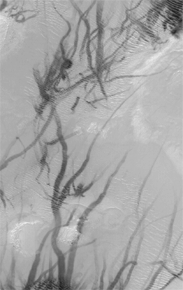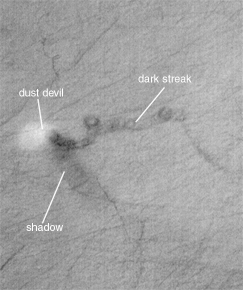

MGS MOC Release No. MOC2-220, 12 March 2000
Argyre Planitia, 21 FEB 2000 MOC2-220-A (805 KBytes)
|
Promethei Terra, 30 DEC 1999 MOC2-220-B (960 KBytes)
|
Dark streaks, everywhere! Many Mars Global Surveyor (MGS) Mars Orbiter Camera (MOC) images of the middle latitudes of the northern and southern hemispheres of Mars show wild patterns of criss-crossing dark streaks. Many of these streaks are straight and narrow, others exhibit curly arcs, twists, and loops. They often cross over hills, run straight across dunes and ripples, and go through fields of house-sized boulders. The two examples shown above were acquired in the last three months. Both pictures are illuminated by sunlight from the upper left. The first picture (left), showing dark streaks on the rippled flats of Argyre Planitia, covers an area 3 km by 5 km (1.9 by 3.1 miles) at a latitude of 51°S. The second picture (right) shows an area approximately 3 km by 5 km in Promethei Terra at a latitude of 58°S.
For many months the MOC science team was seeing streaks such as these, but were uncertain how they formed. One speculation was that they might result from the passage of dust devils. Each dust devil would leave a dark streak by removing bright dust from the terrain in its path, revealing a darker surface underneath. An image described by the MOC team in July 1998 showed examples of streaks that were, at the time, speculated to be caused by dust devils. (To see the July 1998 release, CLICK HERE).
Promethei Terra, 11 DEC 1999 MOC2-220-C (145 KBytes)
|
Terra Sirenum, 23 FEB 2000 MOC2-220-D (2.3 MBytes)
|
In December 1999, the MOC team finally had an answer! A dust devil, shown in the above left figure, was caught in the act of creating a swirly, dark streak! An eerie sensation washed over the first team members who saw this picture---here was an event on Mars "caught in the act" just hours before the picture was played back to Earth. A "smoking gun."
The first dust devil seen making a streak---located in Promethei Terra (above, left)---was traveling from right (east) to left (west). A columnar shadow was cast by sunlight coming from the upper left. This shadow indicates the true shape of the dust devil. The bright dust devil itself does not look like a column because the picture was taken from a camera looking straight down on it. The dust devil is less than 100 meters (less than 100 yards) wide and the picture covers an area approximately 1.5 by 1.7 kilometers (about 1 by 1 mile).
Dust devils are spinning, columnar vortices of wind that move across the landscape, pick up dust, and look somewhat like miniature tornadoes. Dust devils are a common occurrence in dry and desert landscapes on Earth as well as Mars. They form when the ground heats up during the day, warming the air immediately above the surface. As the warmed air nearest the surface begins to rise, it spins. The spinning column begins to move across the surface and picks up loose dust (if any is present). The dust makes the vortex visible and gives it the "dust devil" or tornado-like appearance. On Earth, dust devils typically last for only a few minutes.
The fourth picture (above, right) shows a surface in southwestern Terra Sirenum near 63°S, 168°W, that has seen the activity of so many dust devils that it looks like a plate of dark gray spaghetti. This image, taken in early summer during February 2000, covers an area 3 km wide and 30 km long (1.9 by 19 miles). In fact, a dust devil can be seen in the upper right of this image. Like the other pictures shown here, the Terra Sirenum image is illuminated by sunlight from the upper left.
These pictures are released in conjunction with the 31st Lunar and Planetary Science Conference, being held in Houston, Texas, the week of March 13-17, 2000. These dust devils and streaks are the subject of an oral presentation on the afternoon of March 16, 2000. To view a PDF copy of the abstract, CLICK HERE and note that it is ©2000 Lunar and Planetary Institute.
Malin Space Science Systems and the California Institute of Technology built the MOC using spare hardware from the Mars Observer mission. MSSS operates the camera from its facilities in San Diego, CA. The Jet Propulsion Laboratory's Mars Surveyor Operations Project operates the Mars Global Surveyor spacecraft with its industrial partner, Lockheed Martin Astronautics, from facilities in Pasadena, CA and Denver, CO.